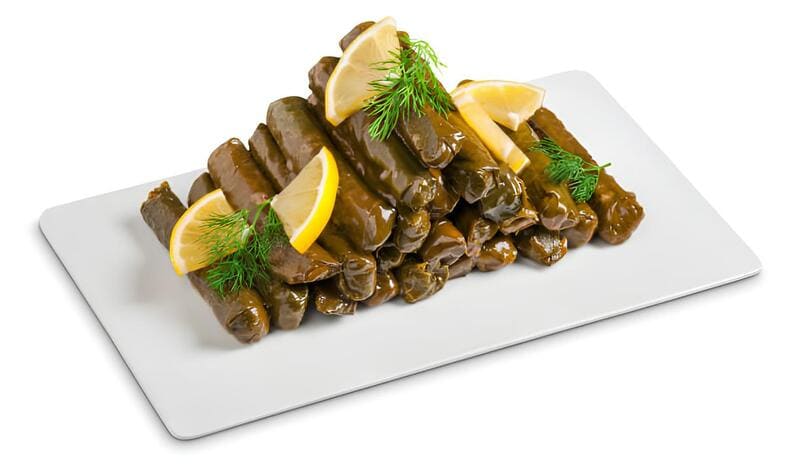
Dolmades, known as dolma in various cultures, are beloved grape leaves stuffed with a savory mixture of rice, herbs, and sometimes meat. Traditionally hailing from the Mediterranean and Middle Eastern regions, this delectable dish has roots in ancient cuisine, showcasing the diverse culinary practices of these areas. Greek, Turkish, and Arab influences make dolmades a versatile and cherished staple.
This recipe will guide you through crafting authentic Egyptian-style dolmades, perfect for festive occasions or everyday enjoyment. The delicate grape leaves encapsulate a filling that’s rich in flavor and nutritious, while a creamy, lemony avgolemono sauce takes it to the next level. Whether prepared as a vegetarian delicacy or with meat, it’s a healthy, wholesome delight.
Ingredients
- 1 onion, finely diced
- 2 tbsp olive oil
- 3-4 garlic cloves (optional)
- 1 lb ground beef (optional; use lamb or omit for vegetarian)
- 2 tsp dried dill (or fresh if available)
- 1 cup medium-grain rice (e.g., risotto or basmati)
- 1 large bunch of parsley, chopped
- Fresh mint, small bunch, chopped
- 1 tsp dried oregano
- Salt and black pepper, to taste
- Lamb shoulder pieces (optional)
- Grape leaves in brine (approx. 35 leaves), rinsed and patted dry
- Juice of 1 lemon
- 4 cups water or vegetable/chicken broth
- 2 egg yolks
- 2-4 tbsp freshly squeezed lemon juice
- 1–1.5 tbsp cornstarch
Preparation
- Heat olive oil in a pot over medium heat, sauté diced onion until soft and golden (10-15 minutes). Add garlic if using.
- In a large bowl, combine ground beef (if using), dried dill, rice, chopped parsley, mint, dried oregano, salt, and pepper.
- Add the sautéed onions (and garlic) to the bowl with the meat and herbs. Mix well.
- Season lamb shoulder pieces (if using) with salt and pepper, and lay them at the bottom of the cooking pot.
- Lay grape leaves shiny side down. Place a tablespoon of filling in the center of each leaf, roll tightly, tucking in sides to form a small package.
- Layer the rolled dolmades seam side down in the pot over the lamb shoulder pieces, ensuring a snug fit.
- Drizzle lemon juice and some olive oil over the dolmades. Place an inverted plate on top to keep them from floating during cooking.
- Add water or broth until dolmades are fully submerged. Bring to a boil, then reduce heat and simmer for 45 minutes or until tender.
- Strain the cooking juices into a saucepan, aiming for approximately 3 cups.
- In a bowl, whisk egg yolks, lemon juice, and cornstarch. Gradually temper with hot broth by adding a small amount at a time, whisking.
- Return the tempered mixture to the saucepan, bring to a boil, and cook until slightly thickened. Remove from heat.
- Pour the avgolemono sauce over the cooked dolmades before serving, or serve on the side for guests to drizzle.
Did you know?
Dolmades are a traditional dish of the Eastern Mediterranean, with roots from ancient times. The name “dolma” stems from the Turkish word “dolmak,” which means “to fill.” This culinary practice of stuffing leaves or vegetables with fillings can be found in various forms across the Middle East, Greece, and Egypt.
In Egypt, grape leaves are commonly used, but cabbage leaves and other vegetables can also be found stuffed with similar mixtures, known as “Mahshi.” The vegetarian or vegan versions of dolmades are popular during the fasting periods in various religious practices, making them a versatile and inclusive dish.
From a nutritional perspective, dolmades are packed with healthy ingredients. The grape leaves are rich in vitamins A and K, while the fresh herbs bring beneficial antioxidants. If you opt for the vegetarian version, it is a low-fat, high-fiber option that supports a healthy diet. On the other hand, adding meat increases protein content, making it a more substantial meal.
Dolmades have transcended cultural boundaries and are enjoyed worldwide, often customized to fit local tastes and available ingredients. Whether as a starter or a main course, this dish continues to enchant with its blend of textures and flavors, embodying the rich tapestry of its origins.
